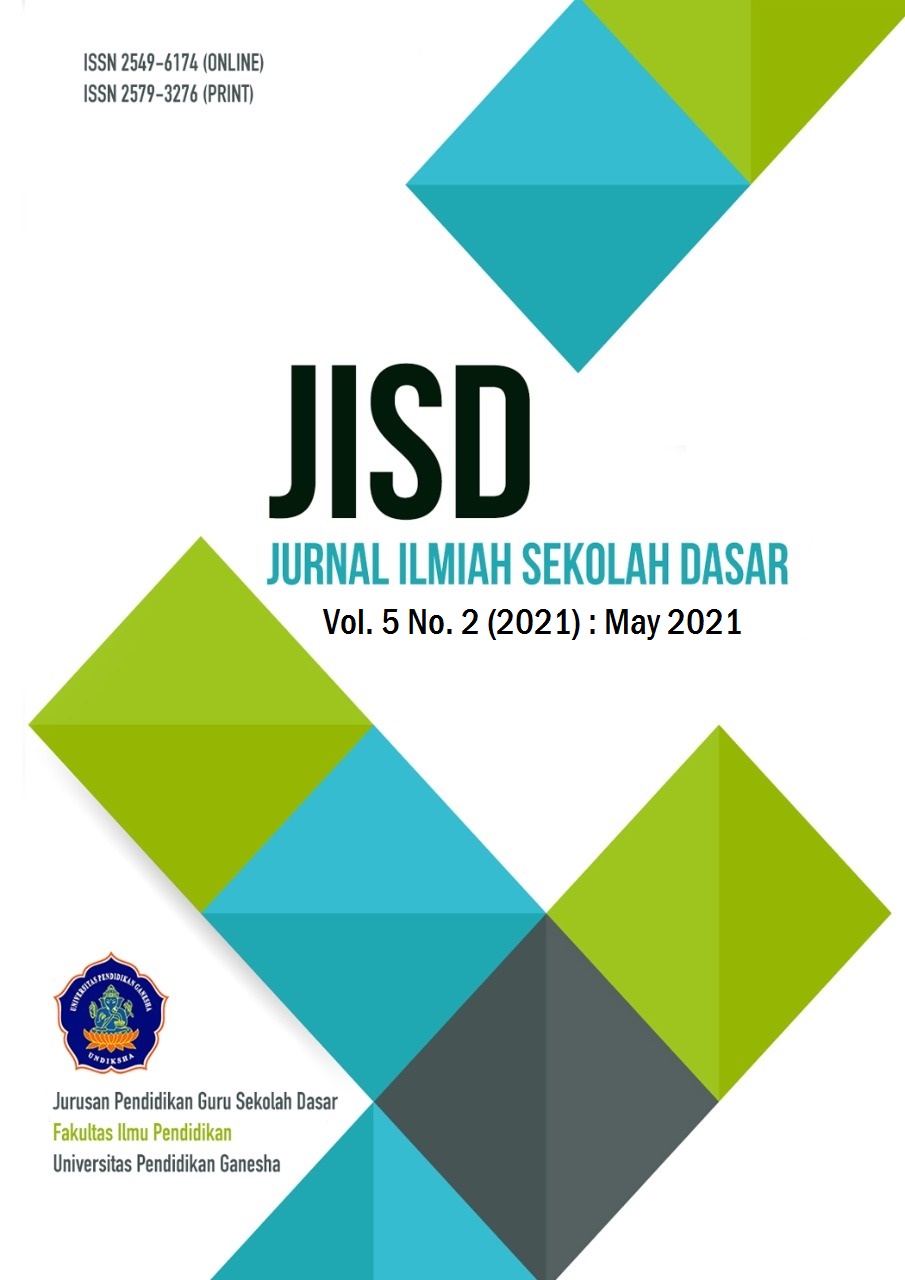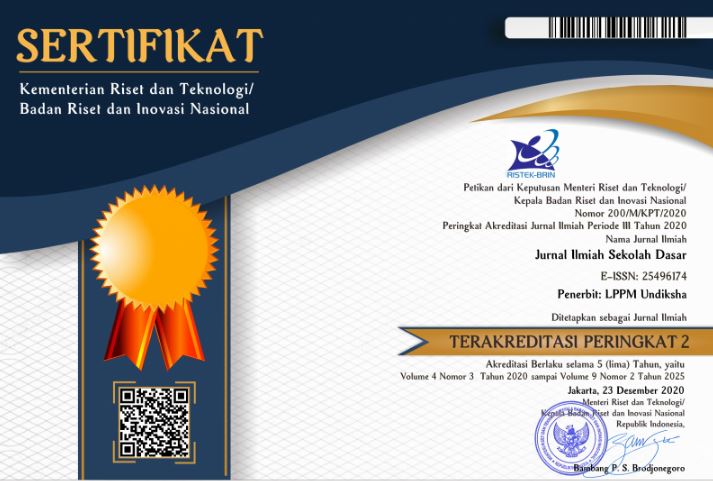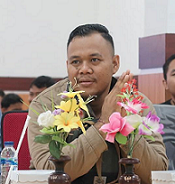Mathematics E-LKPD with Project-Based Learning and HOTS Activities
DOI:
https://doi.org/10.23887/jisd.v5i2.35516Keywords:
e-LKPD, project based learning, HOTSAbstract
Less attractive learning media causes low interest in student learning. So, the need for concrete learning media following the stages of student development. This study aimed to create a valid and practical demonstration-based learning video on changing objects in the fifth grade of elementary school. This research is development research using the 4D model. The subjects of this study were two material experts, two media experts, two practitioners, and five students. The method used in data collection in this study is the rating scale method with an instrument in the form of a rating scale ranging from 1-4. The data obtained were analyzed by calculating the validity index of expert judgment and calculating the average response of practitioners and students. The analysis results showed that the material expert's validity index obtained the lowest score of 0.84 and the highest score was 1 with the very good category. The media expert validity index got the lowest score of 0.67 in the good category, and the highest score was 1, which is in the very good category. The overall average score of the practitioner's response was 3.82, and the student response was 3.78, which was in the very good category. Based on the results of this analysis, demonstration-based instructional video media on the topic of changing objects in fifth-grade elementary schools were declared good and suitable for use in the learning process.
References
Agung, A. A. . (2014). Metodologi Penelitian Pendidikan. Aditya Media Publishing.
Ahmad, S., Kenedi, A. K., & Masniladevi, M. (2018). Instrumen Hots Matematika Bagi Mahasiswa Pgsd. JURNAL PAJAR (Pendidikan Dan Pengajaran), 2(6), 905. https://doi.org/10.33578/pjr.v2i6.6530.
Al Farisyi, S., Syafe’i, I., & Dinda Pratiwi, D. (2016). Modul Elektronik Matematika Berpendekatan Contextual Teaching Learning untuk Peserta Didik MTS kelas VII. Prosiding Seminar Nasional Matematika Dan Pendidikan Matematika UIN Raden Intan Lampung, 423–431.
Amir, A. (2014). Pembelajaran Matematika SD dengan Menggunakan Media Manipulatif. Forum Paedagogik, 06(01), 72–89.
Anderson, L. W., Krathwohl, D. R., & Bloom, B. S. (2001). A taxonomy for learning, teaching, and assessing: a revision of Bloom’s taxonomy of educational objectives. 41(4), 352.
Antara, I. G. W. S., Sudarma, I. K., & Dibia, I. K. (2020). The Assessment Instrument of Mathematics Learning Outcomes Based on HOTS Toward Two-Dimensional Geometry Topic. Indonesian Journal Of Educational Research and Review, 3(1), 19. https://doi.org/10.23887/ijerr.v3i2.25869.
Apriyanto, C., Yusnelti, & Asrial. (2019). Development of E-LKPD with Scientific Approach of Electrolyte and Non-ElectrolyteSolutions. Journal of Indonesian Society of Integrated Chemistry, 11(1), 38–42.
Dwiantoro, A., & Basuki, I. (2021). Analisis Pengaruh Model Pembelajaran Project Based Learning Terhadap Peningkatan Hasil Belajar Siswa Pada Mata Pelajaran Instalasi Penerangan Listrik Di Smk. Pendidikan Teknik Elektro, 10, 81–88.
Dwiranata, D., Pramita, D., & Syaharuddin, S. (2019). Pengembangan Media Pembelajaran Matematika Interaktif Berbasis Android Pada Materi Dimensi Tiga Kelas X SMA. Jurnal Varian, 3(1), 1–5. https://doi.org/10.30812/varian.v3i1.487.
Emda, A. (2018). Kedudukan Motivasi Belajar Siswa Dalam Pembelajaran. Lantanida Journal, 5(2), 172. https://doi.org/10.22373/lj.v5i2.2838.
Fanani, A., & Kusmaharti, D. (2014). Pengembangan Pembelajaran Berbasis HOTS (Higher Order Thinking Skill) di Sekolah Dasar Kelas V. Jurnal Penndidikan Dasar, 1(9), 1–11.
Guo, P., Saab, N., Post, L. S., & Admiraal, W. (2020). A review of project-based learning in higher education: Student outcomes and measures. International Journal of Educational Research, 102(April), 101586. https://doi.org/10.1016/j.ijer.2020.101586.
Handayani, E. S. (2017). Pengaruh Model Pembelajaran Kooperatif Tipe Number Heads Together (NHT) Terhadap Hasil Belajar Sejarah. Jurnal Pendidikan Sejarah, 5(2), 16. https://doi.org/10.21009/jps.052.02.
Hapsari, D. I., Airlanda, G. S., Profesi, P., Universitas, G., & Satya, K. (2018). Penerapan Project Based Learning Untuk Meningkatkan Motivasi Belajar Matematika Peserta Didik Kelas V Implementation of Project Based Learnng To Improve Mathematics Learning Motivation the. Jurnal Pendidikan Dasar Islam, 5(2), 154–161.
Hardianto, D. (2011). Penerapan Prinsip Desain Multimedia Untuk Pembelajaran. International Conference Proceeding “ICT in Education For Peace,” 1, 3.
Hastari, G. A. W., Agung, A. A. G., & Sudarma, I. K. (2019). Pengembangan Modul Elektronik Berpendekatan Kontekstual Pada Mata Pelajaran Ilmu Pengetahuan Sosial Kelas Viii Sekolah Menengah Pertama. EDUTECH Universitas Pendidikan Ganesha, 7, 33–43.
Indaryati, I., & Jailani, J. (2015). Pengembangan Media Komik Pembelajaran Matematika Meningkatkan Motivasi Dan Prestasi Belajar Siswa Kelas V. Jurnal Prima Edukasia, 3(1), 84–96. https://doi.org/10.21831/jpe.v3i1.4067.
Inthachot, M., Sopeerak, S., & Rapai, N. (2013). The Development of a U-learning Instructional Model Using Project based Learning Approach to Enhance Students’ Creating-innovation Skills. Procedia - Social and Behavioral Sciences, 103, 1011–1015. https://doi.org/10.1016/j.sbspro.2013.10.426.
Jarvis, M. A., & Baloyi, O. B. (2020). Scaffolding in reflective journaling: A means to develop higher order thinking skills in undergraduate learners. International Journal of Africa Nursing Sciences, 12(October 2019), 100195. https://doi.org/10.1016/j.ijans.2020.100195.
Kamarullah, K. (2017). Pendidikan Matematika Di Sekolah Kita. Al Khawarizmi: Jurnal Pendidikan Dan Pembelajaran Matematika, 1(1), 21. https://doi.org/10.22373/jppm.v1i1.1729.
Khotimah, S. K. (2020). Pengembangan E-LKPD Matematika Berbasis Penguatan Pendidikan Karakter (PPK) Kelas V SD. Pengembangan E-LKPD Matematika Berbasis Penguatan Pendidikan Karakter (PPK) Kelas V SD, 4, 407.
Kresno, Y. R. (2013). LKP: Pembuatan Buku Company Profile PT. Karya Jaya Lestari sebagai Media Operasional dan Inventaris Perusahaan. STIKOM Surabaya.
Masykur, R., Nofrizal, N., & Syazali, M. (2017). Pengembangan Media Pembelajaran Matematika dengan Macromedia Flash. Al-Jabar : Jurnal Pendidikan Matematika, 8(2), 177. https://doi.org/10.24042/ajpm.v8i2.2014.
Muhson, A. (2010). Pengembangan Media Pembelajaran Berbasis Teknologi Informasi. Jurnal Pendidikan Akuntansi Indonesia, 8(2). https://doi.org/10.21831/jpai.v8i2.949.
Mulyati, T. (2016). Kemampuan Pemecahan Masalah Matematis Siswa Sekolah Dasar (Mathematical Problem Solving Ability of Elementary School Students). EDUHUMANIORA: Jurnal Pendidikan Dasar, 3(2), 1–20.
Niswara, R., Fita, M., & Untari, A. (2019). Pengaruh Model Project Based Learning Terhadap High Order Thinking Skill. Mimbar PGSD Undiksha, 7(2), 85–90.
Noviyana, H. (2017). Pengaruh Model Project Based Learning Terhadap Kemampuan Berpikir Kreatif Matematika Siswa. JURNAL E-DuMath, 3(2). https://doi.org/10.26638/je.455.2064.
Nurita, T. (2019). Development of circle learning media to improve student learning outcomes. Journal of Physics: Conference Series, 1321(2), 171–187. https://doi.org/10.1088/1742-6596/1321/2/022099.
Pane, A. (2017). Belajar dan Pembelajaran Aprida Pane Muhammad Darwis Dasopang. Fitrah, 03(2), 333–352.
Pansa, H. E. (2017). Pengembangan Lkpd Dengan Model Problem Based Learning ( Pbl ) Untuk Meningkatkan Kemampuan. Seminar Nasional Matematika Dan Pendidikan Matematika 2017, 229–238.
Pratiwi, W. (2019). Optimalisasi Pendekatan Saintifik Dengan Pembelajaran Inkuiri Untuk Meningkatkan Kemampuan Berpikir Kritis Di Madrasah Ibtidaiyah. INSANIA : Jurnal Pemikiran Alternatif Kependidikan, 23(2), 174–191. https://doi.org/10.24090/insania.v23i2.2289.
Purnama, M. D., Irawan, E. B., & Sa’dijah, C. (2017). Pengembangan Media Box Mengenal Bilangan Dan Operasinya Bagi Siswa Kelas 1 di SDN Gadang 1 Kota Malang. Jurnal Kajian Pembelajaran Matematika, 1(1), 46–51.
Puspita, V., & Dewi, I. P. (2021). Efektifitas E-LKPD berbasis Pendekatan Investigasi terhadap Kemampuan Berfikir Kritis Siswa Sekolah Dasar. Jurnal Cendekia : Jurnal Pendidikan Matematika, 5(1), 86–96. https://doi.org/10.31004/cendekia.v5i1.456.
Saefudin, A. A. (2012). Pengembangan Kemampuan Berpikir Kreatif Siswa Dalam Pembelajaran Matematika Dengan Pendekatan Pendidikan Matematika Realistik Indonesia (PMRI). Al-Bidayah, 4(1), 37–48.
Sari, F. N., Nurhayati, & Soetopo, S. (2017). Pengembangan Lembar Kerja Peserta Didik (LKPD) Elektronik Teks Cerita Pendek Berbasis Budaya Lokal. Seminar Nasional Pendidikan Bahasa Indonesia, 1, 83–98.
Sitepu, V. (2006). Panduan mengenal desain grafis. Diambil Dari Http://Www. Belajargrafis. Imywebsit.
Suartama, I. K. (2010). Kualitas Pembelajaran Pada Mata Kuliah Media. Jurnal Pendidikan Dan Pengajaran, 43(3), 253–262.
Sudarma, I. K., Teguh, I. M., & Prabawa, D. G. A. P. (2015). Desain Pesan Kajian Analitis Desain Visual Teks dan Image. Yogyakarta: Graha Ilmu.
Syatriadin. (2018). N u a n s a. 2018, 23–32.
Tafonao, T. (2018). Peranan Media Pembelajaran Dalam Meningkatkan Minat Belajar Mahasiswa. Jurnal Komunikasi Pendidikan, 2(2), 103. https://doi.org/10.32585/jkp.v2i2.113.
Ulfa, I., Rahayu Sesanti, N., & Yulianti. (2020). Pengembangan E-LKPD dengan Pendekatan Contextual Teaching and Learning (CTL) pada Materi Pecahan di kelas IV MI Azharul Ulum Sukodono Dampit. Journal of Chemical Information and Modeling, 53(9), 1689–1699.
Wahyu, R., Islam, U., & Rahmat, R. (2018). Implementasi Model Project Based Learning ( PJBL ) Ditinjau dari Penerapan Implementasi Model Project Based Learning ( PJBL ) Ditinjau dari Penerapan Kurikulum 2013. Teknoscienza, 1(1), 50–62.
Widyastuti, N. S., & Pujiastuti, P. (2014). Pengaruh Pendidikan Matematika Realistik Indonesia (Pmri) Terhadap Pemahaman Konsep Dan Berpikir Logis Siswa. Jurnal Prima Edukasia, 2(2), 183. https://doi.org/10.21831/jpe.v2i2.2718.
Yijing, L., Su, Y., Lin, Y., He, L., Wu, L., Hou, X., & Zheng, C. (2020). Jo ur l P re of. Building and Environment, 184(August), 107229. https://doi.org/10.1016/j.heliyon.2021.e07309.
Zakiy, M. A. Z., Muhammad, S., & Farida. (2018). Pengembangan Media Android dalam Pembelajaran Matematika. TRIPLE S:Jourals of Mathematics Education, 1(2), 87–96.
Downloads
Published
How to Cite
Issue
Section
License
Authors who publish with the Journal Ilmiah Sekolah Dasar agree to the following terms:
- Authors retain copyright and grant the journal the right of first publication with the work simultaneously licensed under a Creative Commons Attribution License (CC BY-SA 4.0) that allows others to share the work with an acknowledgment of the work's authorship and initial publication in this journal.
- Authors are able to enter into separate, additional contractual arrangements for the non-exclusive distribution of the journal's published version of the work (e.g., post it to an institutional repository or publish it in a book), with an acknowledgment of its initial publication in this journal.
- Authors are permitted and encouraged to post their work online (e.g., in institutional repositories or on their website) prior to and during the submission process, as it can lead to productive exchanges, as well as earlier and greater citation of published work. (See The Effect of Open Access)










